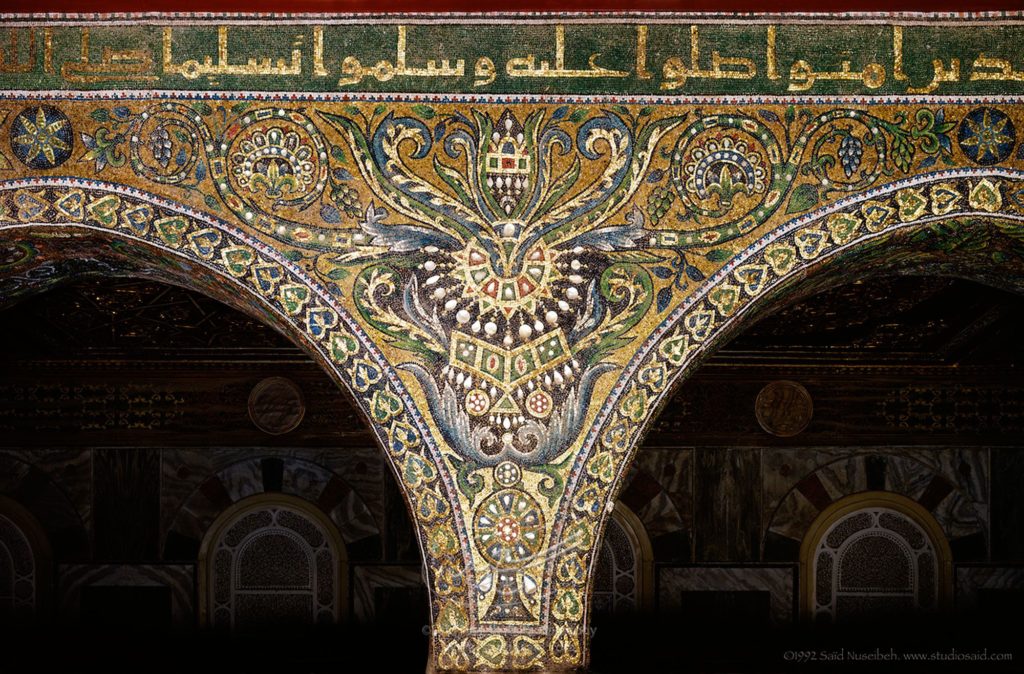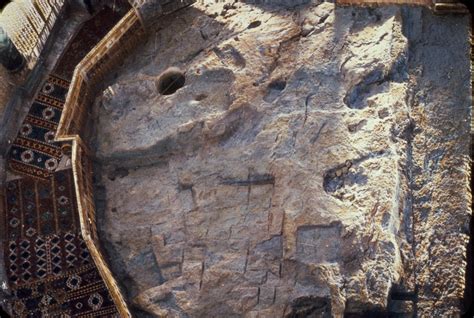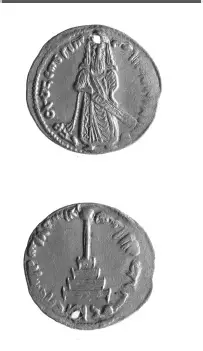
The first documented mention of Islam came during the reign of ‘Abd al-Malik ibn Marwan, who assumed power in the year 680 AD, 60 AH. ‘Abd al-Malik declared that his state was ruled by Islam, its Prophet Muhammad, and that its Lord was one without a partner. He then issued coins inscribed with ‘Abd al-Malik Khalifat Allah’ along with other coinage that bore the name of Muhammad but at the same time depicted the house of the Hebrew god El, symbolized by a stone column in the middle of the coin with an inscription around it running: “There is no god but God alone, Muhammad is the Messenger of God". [1]
ABD AL-MALIK LATER established what is known as the ‘Mosque of the Rock’, an imposing structure with eight ribs and sixteen columns supporting the roof, and topped with a dome. Qur’anic verses were written on its eight external facades as well as on the inside. On the external side was written the following:
In the name of God, the Merciful the Compassionate. There is no god but God. He has no associate. Say: He is God, the One! God, the eternally Besought of all! He begetteth not nor was begotten. And there is none comparable unto Him. Muḥammad is the Messenger of God, the blessing of God be on him. Lo! God and His angels shower blessings on the Prophet. O ye who believe! Ask blessings on him and salute him with a worthy salutation. Praise be to God, Who hath not taken unto Himself a son, and Who hath no partner in the Sovereignty, nor hath He any protecting friend through dependence. And magnify Him with all magnificence. Muḥammad is the Messenger of God, the blessing of God be on him and the angels and His prophets and peace be on him, and may God have mercy … The dome was built by servant of God ʿAbd …May God accept from him and be content with him. Amen, Lord of the worlds, praise be to God.
On the inner wall was written:
O People of the Book! Do not exaggerate in your religion nor utter aught concerning God save the truth. The Messiah, Jesus son of Mary, was only a Messenger of God, and His Word which He conveyed unto Mary, and a spirit from Him. So believe in God and His messengers, and say not ‘Three’ – Cease! (it is) better for you! – God is only One God. Far be it removed from His transcendent majesty that He should have a son. His is all that is in the heavens and all that is in the earth. And God is sufficient as Defender. The Messiah will never scorn to be a servant unto God, nor will the favoured angels. Whoso scorneth His service and is proud, all such will He assemble unto Him. Oh God, bless Your Messenger and Your servant Jesus son of Mary. Peace be on him the day he was born, and the day he dies, and the day he shall be raised alive! Such was Jesus, son of Mary, (this is) a statement of the truth concerning which they doubt. It befitteth not (the Majesty of) God that He should take unto Himself a son. Glory be to Him! When He decreeth a thing, He saith unto it only: Be! and it is. … Those who (formerly) received the Book differed only after knowledge came unto them, through transgression among themselves.
Did ‘Abd al-Malik intend the Dome of the Rock to be a mosque or just a building to compete with the Hagia Sophia basilica in Constantinople and the Church of the Resurrection in Jerusalem? If it was intended to be a mosque for Muslims, then we note that this mosque does not have a mihrab pointing towards the Ka‘ba, which at that time had become the qibla of Muslims after Muhammad moved his qibla from Jerusalem, as the books in the traditional heritage say. The building also has twelve columns representing the twelve tribes of Israel. Moreover, all the internal verses talk about the Children of Israel and Jesus. As for the rock in the middle, from which the building took its name, we do not know its purpose. Is it the rock over which Jacob wrestled with his Lord, as in the Jewish faith, or is it the rock from which according to Christians Jesus ascended to heaven. Or is it the twin to the black stone in the Ka‘ba? Islam – according to the teachings of its Prophet – does not have a rock. The Qur’an states:
Glorified be He Who carried His servant by night from the Inviolable Place of Worship (al-Masjid al-Haram) to the Far distant place of worship (al-Masjid al-Aqsa) the neighbourhood whereof We have blessed [2]
Of course, before the construction of this dome in the year 72 AH, there was no Al-Aqsa Mosque in Jerusalem, but there was the Church of the Resurrection and the remains of Solomon’s Temple, as the Jews claim. There are those who therefore doubt that ‘Abd al-Malik intended the building to be a mosque.
There are those who therefore doubt that ‘Abd al-Malik intended the building to be a mosque
As for the word ‘Muslim’, this only appeared in written form in the Abbasid era. Coins, wall inscriptions, and non-Islamic sources do not mention the word ‘Muslim’ at all.[3] Non-Islamic sources refer to Muhammad’s followers as Hagarites after Abraham’s wife Hagar, who bore him Ishmael. The word was used as a derogatory term for them on the grounds that they were the children of the maid. In Egypt, the word ‘Muslim’ for the first times appears at the end of the memoirs of the Coptic Bishop John of Nikiu, around the year 70 AH. Here he says that many Christians were not real Christians and had abandoned their religion and embraced the religion of Muslims.
The empires at that time used papyrus in official correspondence, and at the top of the enveloping roll of papyrus were written Christian verses in Greek or Syriac. Al-Baladhuri says that ‘Abd al-Malik ibn Marwan was the first to use Qur’anic verses at the top of the papyrus, which researchers term protocols. During the era of Mu’awiya government administration used the Greek and Arabic languages for these protocols, and these were devoid of any Islamic expressions.[4]
Hostility between Christianity and Islam only appeared during the reign of ‘Abd al-Malik, especially in Egypt when it was under the command of ‘Abd al-Aziz ibn Marwan, the younger brother of ‘Abd al-Malik. Around the year 69 AH, ‘Abd al-Aziz ordered the destruction of all crosses in Egypt and commanded that on all the doors of all churches there should be written ‘Muhammad the Great Messenger,’ as stated in the memoirs of Bishop John mentioned above.[5] Then Al-Walid bin ‘Abd al-Malik succeeded him, assuming the caliphate after Abd Al-Malik. He ordered the demolition of part of the basilica of John in Damascus, and built the Umayyad Mosque in it.
How is it possible that the Muslims did not preserve what is the most precious book in their lives?
And now we come to the Qur’an itself. The account of the completion of the Revelation taking place before the death of Muhammad, and the compilation of the Qur’an during his lifetime or during the caliphate of Abu Bakr, and again during the caliphate of Uthman, all these are late stories written in the middle of the eighth century AD. The first word written about the Qur’an was found in a manuscript in Medina dated 135 AH, in which only ‘the book of God’ was mentioned, not ‘the Qur’an’.[6] The story that ‘Uthman wrote six copies of the Qur’an and sent it to the cities is also a story without any evidence for it, as researchers have failed to find any of those alleged copies. If ‘Uthman had actually written those copies and sent them to the countries, and even if we were to assume that two or three of the copies might have been damaged or burned, how is it possible that the Muslims did not preserve what is the most precious book in their lives? Was there none among the Muslims who preserved even one copy of that great book? Malik bin Anas, when asked about the Mushaf of ‘Uthman, said: “It has gone into occultation, and we have found no trace of it”.[7] The same saying was recorded in the book Al-Masahif by Abu Dawud, quoting Abdullah bin Wahb, who says: “I asked Malik about ‘Uthman’s Mushaf, and he said: It is gone”.[8] Ibn Saad, who transmitted the biography of Ibn Ishaq – the oldest Islamic book – failed to mention anything about the collection of the Qur’an.
Abu Dawud al-Sijistani in his work The Qur’an wrote extensively about the efforts by al-Hajjaj ibn Yusuf to punctuate and rewrite the Qur’an. Many claim that Al-Hajjaj ibn Yusuf erased some verses and inserted others into his Qur’an, which he sent to the regions during the caliphate of ‘Abd al-Malik, which angered ‘Abd al-‘Aziz ibn Marwan on receiving a copy in Egypt. He accordingly ordered the scholars of Egypt to write a Qur’an for him too. ‘Abd al-Malik ibn Marwan’s statement made in the month of Ramadan is known to all: he said that he feared that he would die in Ramadan since it is the month
“in which I was born, in which I was weaned, in which I was pledged allegiance, and in which I collected the Qur’an”.

Suggested Reading
In sum, after studying all the available sources of manuscripts, coins, inscriptions, Islamic heritage books, and sources contemporary with Umayyad and Abbasid rule, it became clear to researchers that Islam did not emerge suddenly and spread over a period of ten years, as the traditional books in the heritage claim. Rather, it began with a political movement led by Qatham in the seventh century AD, which he supported with scriptures that he claimed came to him from heaven, just as scriptures came to Moses and Jesus before him. No doubt there were those who believed in Muhammad and followed him, and spread his message after his death, adding many texts and legendary stories to it that glorified their Prophet.
The message was spread by the power of the sword and not of logic, since the logic of the texts brought by Muhammad cannot convince any sane person who is familiar with religions that preceded the emergence of Muhammad. Efforts were made to add and delete some passages from that sacred text, which Muslims later called the ‘Qur’an’. The form of the Qur’anic texts was not complete until the era of the Umayyad caliph ‘Abd al-Malik ibn Marwan. As for Islamic jurisprudential legislation and much else besides, these took long decades to formulate, to be completed by the end of the Abbasid state.
[1] Karl-Heinz Ohlig and Gerd-R Puin (Edd.), The Hidden Origins of Islam, p. 67. See this work in the Almuslih Library, here.
[2] Qur’an XVII (al-Isra’), 1.
[3] Yehuda D. Nevo, Judith Koren, Crossroads to Islam: the Origins of the Arab Religion and the Arab State, Prometheus Books, Amherst New York 2003, p.234.
[4] Op. cit., p.284.
[5] Op. cit., p.201.
[6] The Hidden Origins of Islam, p. 97.
[7] As stated in the book Al-Wafa’ by Al-Samhoudi, in the chapter ‘The Shaykhs’.
[8] Op. cit., p.205.
Main image: Inscription on the Dome of the Rock interior: “O ye who believe! Ask blessings on him and salute him with a worthy salutation”.
Read Part 1 of this essay here
Read Part 2 of this essay here


